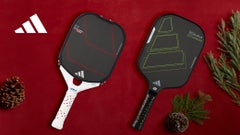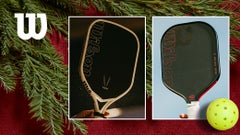How to Defend Against the Body Shot in Pickleball
We explain why the backhand volley is key to learn and how to practice it.
With a lot of the action in pickleball centered around the net, players often have to deal with shots coming in fast and/or aimed at the body! In these scenarios a player has little time to decide whether to use the forehand or backhand wing to deal with body shots.
We will let you in on a little secret: The backhand volley is the more versatile and reliable shot option during fast hand exchanges and when the ball is flying right at you.
Even if you have an average level of experience playing pickleball, we are confident that you have encountered the player or team who likes to slap the ball with pace every possible chance.
Scenario 1: Everyone is near the kitchen, your teammate produces a weak volley, and you are on the receiving end of a hard volley aimed to the body.
Scenario 2: You hit a short return of serve that allows the opposing team to surprise your partner at net with a high-speed forehand groundstroke aimed to the body.
Scenario 3: The random shot flying toward the face area of you or your partner.
In situations like these, the backhand volley offers three-shot versatility. With that shot, you can effectively cover the backhand side, the entire body and a pretty good backhand volley can be hit on the forehand side of your body. All with less footwork required!
How to be Ready for a Backhand Volley
A good ready position anywhere inside the baseline is the same one used while waiting to hit a service return at the baseline. It is the universal athletic position with slightly bent knees, and hips, along with your feet about a shoulder's width apart.
Hold your paddle up high (abdominal/chest area) with the tip up. There should be a slight lean of the paddle toward your backhand side. A slight tilt of the paddle tip toward the backhand wing saves critical time when reacting to quick cross-fire play at the kitchen line and the occasional errant shot flying at your face.
Right-handers lean the paddle toward 11 o'clock, and lefties point the paddle to the 1 o'clock spot.
Drills to Improve Your Backhand Volley
If the ultimate proving ground is competitive point play, the ultimate improving ground is definitely the practice court.
Drill 1: This pattern allows both players to be the focus of the drill. Two players are positioned at the kitchen line and only practice hitting backhand volleys at a "conversational pace." In other words, you are not trying to beat the other player. Instead, volley at a pace that you can carry on a casual conversation at the same time.
Drill 2: Once your feel for consistently hitting backhand volleys improves, try switching the drill to alternating every other shot from the backhand and forehand at the same low-to-medium pace. This pattern illustrates how versatile and effective the backhand volley is because the forehand requires extra anticipation and maneuvering when replying to a body shot.
Drill 3: The player being targeted with body shots is positioned at the NVZ, and the other feeds from various court positions. The feeding player bombards the person at net with a stream of shots aimed to the body. The goal is to maintain a cool head and get used to favoring the backhand volley when dealing with a flurry of shots aimed to your body. Several balls or a bucket full is handy for this drill.
In Conclusion
Many players feel more comfortable hitting a forehand compared to a backhand. That goes for every skill level and is not limited to the volley. When it comes to the volley, especially when all players are close to the kitchen, and shots are directed at your body there is little time to decide whether to reply with a backhand or forehand. Let's recap the three-shot versatility of the backhand volley, why it is a great shot option to use when shots are aimed to the body and how to improve it:
- You can use the backhand volley to hit off of the backhand wing.
- The backhand volley works for covering the body (protecting the face).
- In a pinch, a good backhand volley can be hit off the forehand side.








